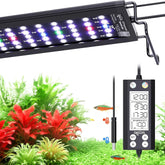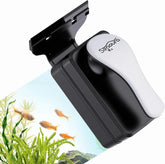Complete Guide to Tropical Fish Keeping: From Beginner to Expert
With their dazzling colors and graceful movements, tropical fish have become one of the most popular aquarium pets. But to keep these exotic creatures thriving in your home, proper care is essential. This comprehensive guide will walk you through all aspects of tropical fish keeping to help you create a vibrant underwater world.
Part 1: Preparation Before Keeping Tropical Fish
1. Choosing the Right Aquarium
-
Size Selection: Beginners should start with a medium-sized tank (40-60cm)
-
Shape Recommendation: Rectangular tanks are most practical with maximum surface area
-
Material: Ultra-clear glass offers best visibility

2. Essential Equipment
-
Filtration System: Hang-on-back filters ideal for beginners (3-5 times tank volume/hour)
-
Heating Equipment: Submersible heater (100W per 50 liters)
-
Lighting System: LED aquarium light (8-10 hours daily)
-
Thermometer: For accurate temperature monitoring
-
Water Test Kits: For pH, ammonia, nitrite testing
3. Aquarium Setup Tips
-
Substrate: Neutral gravel or sand (3-5cm depth)
-
Decorations: Driftwood and rocks must be sterilized
-
Plants: Beginner-friendly species like Java fern or moss
Part 2: Proper Tank Cycling Process
1. Tank Sterilization
Soak tank in diluted potassium permanganate solution (light pink) for 30 minutes then rinse thoroughly
2. Establishing Nitrogen Cycle
-
Set up equipment and fill with water
-
Add nitrifying bacteria starter
-
Cycling period: Minimum 7-10 days
3. Water Parameter Standards
-
Temperature: 24-28°C (varies by species)
-
pH: 6.5-7.5
-
Ammonia: 0 mg/L
-
Nitrite: 0 mg/L
-
Nitrate: <20 mg/L
Part 3: Selecting and Introducing Fish
1. Recommended Beginner Species
| Species | Temperature | Size | Characteristics |
|---|---|---|---|
| Guppy | 22-28°C | 3-5cm | Colorful, easy to breed |
| Neon Tetra | 23-27°C | 3cm | Schooling, affordable |
| Zebra Danio | 18-26°C | 4-5cm | Hardy, adaptable |
| Betta | 24-30°C | 6-8cm | Solitary, doesn't need aeration |

2. Acclimation Process
-
Float sealed bag in tank for 30 minutes
-
Gradually add tank water to bag over 1 hour
-
Net fish into tank (don't pour bag water)
Part 4: Daily Maintenance
1. Feeding Guide
-
Frequency: 1-2 times daily
-
Amount: What they finish in 3 minutes
-
Food Types:
-
Commercial flakes/pellets
-
Frozen bloodworms/brine shrimp (1-2x weekly)
-
Blanched vegetables
-
2. Water Changes
-
Amount: 25-33% weekly
-
Procedure:
-
Turn off heater
-
Siphon out debris
-
Add temperature-matched treated water
-
Use water conditioner
-
3. Equipment Care
-
Rinse filter media monthly (in tank water)
-
Replace partial media quarterly
-
Regularly check heater function

Part 5: Troubleshooting Common Issues
1. Disease Treatment
-
Ich: Raise to 30°C for 3 days or use medication
-
Fin Rot: Improve water quality, use antibacterial
-
Dropsy: Stop feeding, treat with metronidazole
2. Algae Control
-
Green algae: Reduce light, add algae eaters
-
Brown algae: Boost filtration, add bacteria
-
Black beard: Spot treat with glutaraldehyde
3. Abnormal Behaviors
-
Gasping: Immediate aeration, test water
-
Flashing: Possible parasites, quarantine
-
Fasting: Check parameters, try different foods
Part 6: Advanced Techniques
-
Breeding: Set up separate tank with spawning sites
-
Community Tanks: Combine top/mid/bottom dwellers
-
Aquascaping: Learn golden ratio layout for natural look
Conclusion
Tropical fish keeping is a rewarding hobby requiring patience and attention. Remember - stable water conditions are key to success. As you gain experience, you'll be rewarded with their full beauty. Happy fishkeeping!
Note: Different species may have special requirements - always research before purchasing. Share your experiences and questions in the comments!






